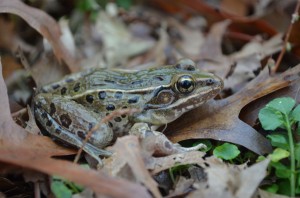New Frog Species Discovered in New York and New Jersey
Posted by: Loren Coleman on March 14th, 2012
So much for the notion that new species are never found in America. Now that is a myth well worth debunking.
A new frog species has been discovered in the USA.
The yet unnamed amphibian is believed to have lived among us for a century without being recognized
In New York City – in the midst of some of the world’s tallest skyscrapers – and within view of the Statue of Liberty, scientists have found a new frog species.
While discovering new species in remote rainforests is common, finding this one in the ponds and marshes of Staten Island, mainland New York, and New Jersey was a big surprise to the scientists from Rutgers University, UCLA, UC Davis, and the University of Alabama who worked together to make the discovery .
The yet unnamed frog – which biologists historically mistook for a more widespread variety of the leopard frog — may even extend into parts of Connecticut and extreme northeastern Pennsylvania. Researchers believe that these are likely the same leopard frogs that completely disappeared from Long Island and other parts of the area over the last few decades.

A yet, unnamed frog species that for the last century scientists thought was a more common leopard frog. Photo Credit: Brian Curry, Rutgers University.
“It is very surprising for a new species like this to have been unrecognized in this area until now,” said Rutgers doctoral candidate and guest researcher at Brookhaven National Laboratory Jeremy Feinberg, who made the initial discovery. “Their naturally limited range coupled with recent unexplained disapperances from places like Long Island underscores the importance of this discovery and the value that conservation efforts might have in the long-term survival of this urban species.”

Jeremy Feinberg, co-author of the study, and doctoral student in the School of Environmental and Biological Sciences
In newly released research, available online in the journal Molecular Phylogenetics and Evolution, scientists used mitochondrial and nuclear DNA data to compare the new frog to all other leopard frog species in the region and determined that it is an entirely new species, soon to be named by the researchers. The wetland species likely once lived on Manhattan, and though it’s now only known to live in a few nearby locations, Yankee Stadium would probably be the bull’s-eye of a target drawn around its current image.
Feinberg, co-author of the study, is working on his doctoral thesis in the School of Environmental and Biological Sciences. He was doing research on the alarming decline of leopard frogs in the wetlands of New York and New Jersey when he noticed that the regional leopard frogs displayed unusual behaviors and peculiar croaks. Instead of the “long snore” or “rapid chuckle” he heard from other leopard frogs, this frog had a short, repetitive croak.
“When I first heard these frogs calling, it was so different, I knew something was very off,” Feinberg said. “It’s what we call a cryptic species: one species hidden within another because we can’t tell them apart by looking. But thanks to molecular genetics, people are really picking out species more and more that would otherwise be ignored.”
To find out if his hunch was right, Feinberg developed a partnership with Cathy Newman, a geneticist who was completing a master’s degree in genetics at the University of Alabama.
The two decided to team up on the project after Newman, who was working on an unrelated study of leopard frogs, asked Feinberg, an ecologist and regional amphibian and reptile expert, for assistance with her research. In this heavily urbanized area Newman expected the frogs to be either of two previously known species, or perhaps a hybrid of both at best. What she found turned out to be a totally new species.
“I was very confident that the genetic results were going to support the idea that this was a new species” Feinberg said. “As Joanna Burger, professor in the Department of Cell Biology and Neuroscience, and Jeremy Feinberg’s advisor on the project far back as the late 1800s scientists have speculated about the odd frogs but until the advent of molecular genetics, it was difficult to prove anything.”
Although the frogs were discovered in the New York, New Jersey metropolitan area, the bulk of the genetics research took place at UC Davis. The results of those “unusual frogs” whose weird sounding calls were different from leopard frogs were clear-cut: the DNA was distinct, no matter how much the frogs looked alike.
What this discovery proves, said Joanna Burger, professor in the Department of Cell Biology and Neuroscience in the School of Arts and Sciences, and Feinberg’s advisor on the project, is that even in densely-populated urban areas new species can be found. Because of the extensive extinctions over the last few decades from habitat destruction, disease, invasive species, pesticides and parasites, it is even more imperative that conservation concerns be addressed, Burger said.
“It is amazing to discover a new frog in Rutgers backyard and the metropolitan area of New York and New Jersey that was among us for a century without being recognized,” Burger said. “We need to do all we can to make sure that we protect it.”

Joanna Burger, professor in the Department of Cell Biology and Neuroscience, and Jeremy Feinberg’s advisor on the project.
Thanks to a news release from Rutgers University.
About Loren Coleman
Loren Coleman is one of the world’s leading cryptozoologists, some say “the” leading living cryptozoologist. Certainly, he is acknowledged as the current living American researcher and writer who has most popularized cryptozoology in the late 20th and early 21st centuries.
Starting his fieldwork and investigations in 1960, after traveling and trekking extensively in pursuit of cryptozoological mysteries, Coleman began writing to share his experiences in 1969. An honorary member of Ivan T. Sanderson’s Society for the Investigation of the Unexplained in the 1970s, Coleman has been bestowed with similar honorary memberships of the North Idaho College Cryptozoology Club in 1983, and in subsequent years, that of the British Columbia Scientific Cryptozoology Club, CryptoSafari International, and other international organizations. He was also a Life Member and Benefactor of the International Society of Cryptozoology (now-defunct).
Loren Coleman’s daily blog, as a member of the Cryptomundo Team, served as an ongoing avenue of communication for the ever-growing body of cryptozoo news from 2005 through 2013. He returned as an infrequent contributor beginning Halloween week of 2015.
Coleman is the founder in 2003, and current director of the International Cryptozoology Museum in Portland, Maine.










This is an interesting discovery, much like the Giant Crawfish recently discovered in the south. However, what would really get the skeptics to think twice before discounting the possibility of cryptids/unknown species living in North America would be the discovery of a new species of large game, Megafauna, in the US, and not necessarily a Bigfoot or lake beast (perhaps a new species of deer, or perhaps a surviving prehistoric species, like the Stag Moose or Glyptodon. Woodland Bison were thought extinct before they were rediscovered in 20th century Canada, but it was a contemporary animal, not something that died out ages ago, and combined with the “we already documented that animal before” argument, it is still rebuffed by the skeptical elites. The latter skeptical argument would not be so believable a defense from knowledge if it was a Prehistoric Longhorn Bison or something else from remote time.). Once something remotely big and all new is found, the skeptics would have lost a argument; that its one thing to discover something small and new in North America, but another thing to discover a big animal like the Beast of Bray Road or Loveland Frogmen (The bigger they are, the harder to hide and more likely to be mythical argument).
Until new big game is found in North America, whether a well known cryptid or something totally unknown and unexpected, skeptics will brush this discovery off as a faulty example of the possibility of Sasquatch and other large Cryptids in our own backyard, because a new frog is so much smaller than a Gorilla or Elasmosaur.
While I agree with Hapa regarding a large mammal being found I have to add that we won’t find anything if we don’t look. Or more precisely don’t know where/how to look. I often find that people have no concept as to how large an area the Pacific NorthWest Forest is. Google Map it sometime. It is a huge area, densely forested with little to no access in many areas. There ‘could’ be prehistoric megafauna in there and you would never know it. Ask rescue and recovery teams how hard it is to find someone in a forest, and that is a someone who WANTS to be found.
Although I still think it is amazing that any animal in a metropolitan area went undiscovered for so long. Think about the history of the USA, the East Coast was the first to be populated by settlers, the one with the heaviest concentration of people, roads and industry and still something can go unnoticed. I just hope they manage to survive with all the crazy weather we’ve been having over the last 2-3 years.
Just remember there is a BIG difference in ‘discovering’ a new species of animal that was previously known but misidentified (ie this frog being assumed a leopard frog species) and finding a new animal not seen/documented before.
I’ve been lurking here for years, but this story made me want to register and post.
This story proves one thing: It is a lot easier to discover a new species when you are looking for it. In this case a collection of universities banded together to verify the status of this frog species.
Imagine how quick the status of a species would be determined if a concerted/coordinated effort was made to find it, free from “Barnumian” antics and publicity stunts.
The best chance for cryptids to stay hidden is for mainstream science (and mainstream culture) to scoff at anyone who thinks a serious study is warranted.
The best quote for me was: “‘It is very surprising for a new species like this to have been unrecognized in this area until now,’ said Rutgers doctoral candidate and guest researcher at Brookhaven National Laboratory Jeremy Feinberg, who made the initial discovery.”
I can imagine that same quote for the discovery of sasquatch, bigfoot, etc.
Send a team of scientists to the PacNW, with the plan to spend several weeks in deep country. Or send them to the Japanese island with the alleged clouded leopard-type cats, or to the many deep water lakes that supposedly house something, etc.
Cost would be an issue, but it didn’t seem to be a problem for four different universities to “investigate further” regarding the not-a-leopard frog.
Oh, you people are blind! That’s clearly a guy in a frog suit! Show me the body! Show me DNA! Show me a note from it’s mother!
Kidding, just feel like it’s easier to pick up a froggy and snap a pic of it in your little hand than to pick up a little squatchy and snap a pic of THAT in your little hand.